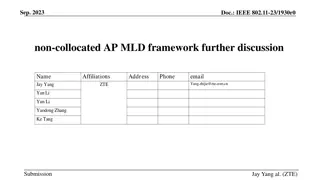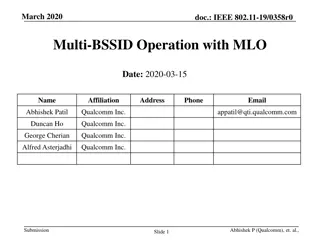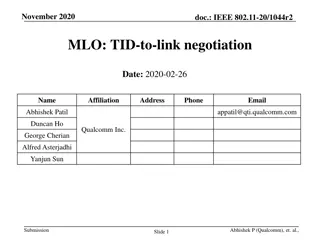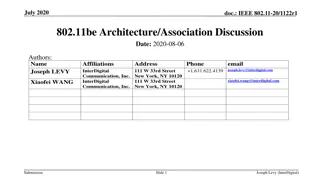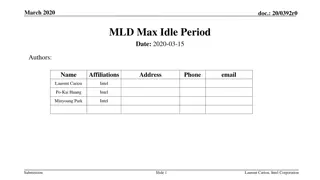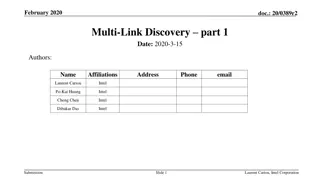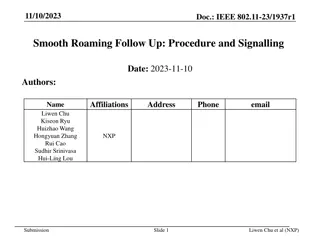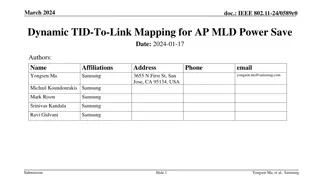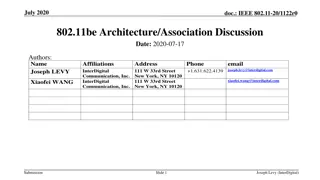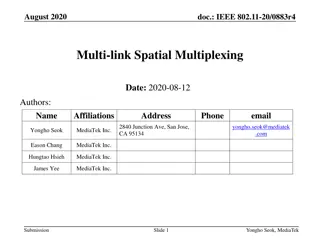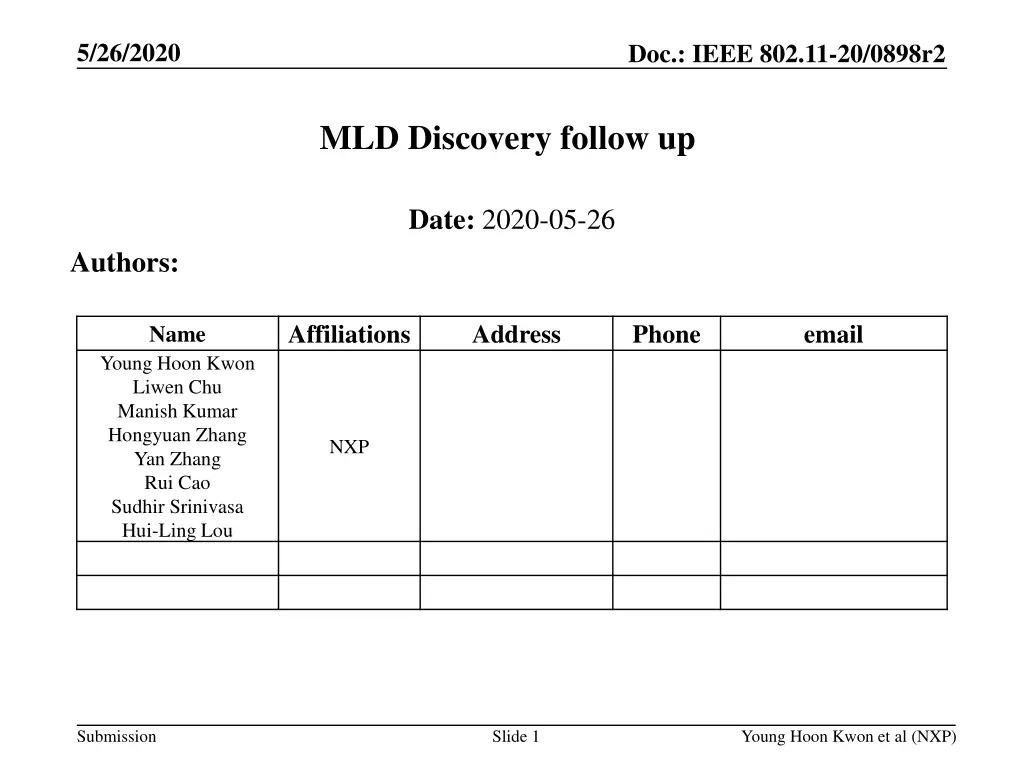
IEEE 802.11-20/0898r2 MLD Discovery Updates
Explore the latest updates on MLD Discovery in the IEEE 802.11-20/0898r2 document, including discussions on Multi-Link elements, RNR elements, and Beacon frame enhancements for improved network discovery and communication protocols.
Download Presentation

Please find below an Image/Link to download the presentation.
The content on the website is provided AS IS for your information and personal use only. It may not be sold, licensed, or shared on other websites without obtaining consent from the author. If you encounter any issues during the download, it is possible that the publisher has removed the file from their server.
You are allowed to download the files provided on this website for personal or commercial use, subject to the condition that they are used lawfully. All files are the property of their respective owners.
The content on the website is provided AS IS for your information and personal use only. It may not be sold, licensed, or shared on other websites without obtaining consent from the author.
E N D
Presentation Transcript
5/26/2020 Doc.: IEEE 802.11-20/0898r2 MLD Discovery follow up Date: 2020-05-26 Authors: Affiliations Address Phone email Name Young Hoon Kwon Liwen Chu Manish Kumar Hongyuan Zhang Yan Zhang Rui Cao Sudhir Srinivasa Hui-Ling Lou NXP Submission Slide 1 Young Hoon Kwon et al (NXP)
5/26/2020 Doc.: IEEE 802.11-20/0898r2 Recap: Following consensus has been made on MLO discovery: All APs that are part of the same MLD as a reporting AP and that are collocated with the reporting AP shall be reported in the RNR element that is included in the beacons and the broadcast probe responses transmitted by the reporting AP when the reporting AP is either not part of a multiple BSSID set or corresponds to a transmitted BSSID in a multiple BSSID set. Note: an AP is not included if it is not discoverable. Note: RNR provides basic information (e.g., operating class, channel, BSSID, short SSID). 802.11be agrees to define a mechanism for a STA of a non-AP MLD to send a probe request frame to an AP belonging to an AP MLD, which enables to request a probe response from the AP that includes the complete set of capabilities, parameters and operation elements of other APs affiliated to the same MLD as the AP The complete information is defined as all elements that would be provided if the reported AP was transmitting that same frame (exceptions TBD). It is TBD if the AP is mandated or not to respond with the requested information. Note: Such a directed probe request requesting complete MLO information for one or more APs of the MLD is referred to as an ML probe request. Note: A probe response sent in response to an ML probe request containing complete MLO Information for the requested AP(s) is referred to as an ML probe response. Submission Slide 2 Young Hoon Kwon et al (NXP)
5/26/2020 Doc.: IEEE 802.11-20/0898r2 Recap: 802.11be agrees to define a new Multi-Link element (MLE) to report/describe multiple STAs of an MLD with at least the following characteristics: MLD-level information may be included A STA profile subelement is included for each reported STA (if any) and is made of a variable number of elements describing this STA Note: a control field for the element is not considered as MLD-level information. Note: Name can be changed. In this contribution, we discuss further on details on RNR and ML elements in Beacon and Probe Request/Response frames. Submission Slide 3 Young Hoon Kwon et al (NXP)
5/26/2020 Doc.: IEEE 802.11-20/0898r2 RNR element RNR element shall be included in a Beacon frame from an EHT AP. A STA profile of an ML element includes elements describing a reported AP. If the STA profile indicates complete information, all elements that would be included in the reported AP s Beacon frame will be included (exceptions TBD). As RNR element shall be included in a Beacon frame, it may imply that RNR element will be included in each STA profile of the ML element. However, RNR elements from co-located APs are most likely duplicated. If Beacon and/or Probe Response frame includes RNR element, it is not useful to include additional RNR element in each STA profile of ML elements that included in the Beacon and/or Probe Response frame. Similar reason, in 11ax RNR element is not included in the multiple BSSID element: An AP with dot11MultiBSSIDImplemented equal to true shall not include Reduced Neighbor Report element in the Nontransmitted BSSID Profile subelement of the Multiple BSSID element. We propose: An AP shall not include a RNR element in a STA profile subelement of a Multi- Link (ML) element. Submission Slide 4 Young Hoon Kwon et al (NXP)
5/26/2020 Doc.: IEEE 802.11-20/0898r2 ML/MBSSID elements Which APs to be included in an ML element? Operation example: A STA sends a Probe Request frame to AP12 to request for complete information of other APs affiliated to MLD2. As AP12 has a nontransmitted BSSID, AP11 sends a Probe Response frame including: Elements for AP11 MBSSID element (MB1) including Nontransmitted BSSID profile for AP12 Elements for AP12 ML element (ML1) including STA profile for AP22 Elements for AP22 Should a MBSSID element (MB2) be included? If included, it gives information on AP21. Should a ML element (ML2) be included? If included, it gives information on AP12. Should a ML element (ML3) be included? If included, it gives information on AP21 & AP31. MLD1 MLD2 Link1 AP11(T) AP12(N) MB1 ML1 ML2 ML3 Link2 AP21(N) AP22(T) MB2 Link3 AP31(T) AP32(N) MB3 Submission Slide 5 Young Hoon Kwon et al (NXP)
5/26/2020 Doc.: IEEE 802.11-20/0898r2 ML/MBSSID elements Discussions: MBSSID element (MB2) needs to be included in the ML element (ML1) within MB1 unless we define an exception because Each STA profile subelement for a reported AP will include all elements that would be included in the reported AP s Beacon frame (exceptions TBD). MBSSID element would be included in AP22 s Beacon frame. This means that eventually the ML1 includes information of AP22 and AP21. Is inclusion of AP21 original intention? Inclusion of ML2 is meaningless. However, what if AP22 s Beacon frame also includes ML element? E.g., ML element indicating partial information of AP12. AP11 does not need to include the ML element (ML3) in the Probe Response frame because information on MLD1 has not been requested. If AP11 is willing to include ML3, it may still include it. If AP 11 includes ML3 to indicate information of MLD1, it eventually includes information of AP21, AP31, and AP32 (due to MB3). Information of AP21 is duplicated. MLD1 MLD2 Link1 AP11(T) AP12(N) MB1 ML1 ML2 ML3 Link2 AP21(N) AP22(T) MB2 Link3 AP31(T) AP32(N) MB3 Submission Slide 6 Young Hoon Kwon et al (NXP)
5/26/2020 Doc.: IEEE 802.11-20/0898r2 ML/MBSSID elements It is possible that having ML element and MBSSID element intermingled together may end up with duplicated indication of same AP. An AP on other link can be indicated by multiple route: ML element MBSSID element MBSSID element ML element ML element in a STA profile of another ML element will create infinite loop. We better not to allow an ML element to be included in a STA profile of another ML element. Submission Slide 7 Young Hoon Kwon et al (NXP)
5/26/2020 Doc.: IEEE 802.11-20/0898r2 ML/MBSSID elements To avoid duplicated indication: An AP shall not include a MBSSID element in a STA profile subelement of a Multi-Link (ML) element. An ML element shall not be included in a STA profile of another ML element. Submission Slide 8 Young Hoon Kwon et al (NXP)
5/26/2020 Doc.: IEEE 802.11-20/0898r2 Retrieval of a BSS information Change Sequence fields are introduced to indicate if there s any update on BSS parameters on other links of an AP MLD. 802.11be supports that an AP within an AP MLD shall include in the Beacon and Probe Response frames it transmits the Change Sequence fields that indicate changes of system information for other APs within the same AP MLD, where the change sequence field value for the reported AP is initialized to 0, that increments as the critical update of the reported AP is occurred. The signaling of the Change Sequence field is TBD. The critical updates are defined in 11.2.3.15 (TIM Broadcast) and the additional update can be added if needed. However, it is not clear when the change sequence is checked and when to retrieve the BSS information. Submission Slide 9 Young Hoon Kwon et al (NXP)
5/26/2020 Doc.: IEEE 802.11-20/0898r2 Retrieval of a BSS information If a STA wakes up on a link and the STA intends to transmit a frame to an AP operating on the link: The STA doesn t need to check change sequence considering the baseline operation. If a STA receives a Beacon frame on a link and the received change sequence value for another link is different from the value that it stored for the AP, but the STA does not intend to access the other link: The STA doesn t need to retrieve information of the AP operating on the other link because the STA is not planning to access the other link. A STA MLD made a multi-link setup with an AP MLD without receiving ML probe response on a link, and the STA intends to access other link: The STA needs to retrieve the most recent parameters for the AP operating on the link before accessing the link. If a link is enabled from a disabled state for a STA based on TID-link mapping negotiation, and the STA intends to access the link: The STA needs to retrieve the most recent parameters for the AP operating on the link before accessing the link. If a STA receives a Beacon frame on a link and the received change sequence value for another link is different from the value that it stored for the AP, and the STA intends to access the other link: The STA needs to retrieve the most recent parameters for the AP operating on the link before accessing the link. Submission Slide 10 Young Hoon Kwon et al (NXP)
5/26/2020 Doc.: IEEE 802.11-20/0898r2 Retrieval of a BSS information A STA of a non-AP MLD doesn t need to retrieve a BSS information whenever receiving a newer change sequence value. However, a non-AP MLD shall not operate on the link until it retrieved the most recent parameters for the AP operating on that link. The non-AP STA may retrieve the most recent parameters by receiving a Beacon frame from the AP or sending a Probe Request frame to the AP. The non-AP STA may determine that it does not have the most recent parameters by receiving a change sequence for that AP that is different than the change sequence it stored for that AP. Submission Slide 11 Young Hoon Kwon et al (NXP)
5/26/2020 Doc.: IEEE 802.11-20/0898r2 Summary Duplicated RNR/ML/MBSSID elements in a Probe Response frame are discussed. Also, condition for retrieval of a BSS information is discussed. Submission Slide 12 Young Hoon Kwon et al (NXP)
5/26/2020 Doc.: IEEE 802.11-20/0898r2 SP1 Do you agree to add the following to R1 of 11be SFD: An AP shall not include a RNR element in a STA profile subelement of a Multi-Link (ML) element. An AP shall not include a MBSSID element in a STA profile subelement of a Multi-Link (ML) element. An ML element shall not be included in a STA profile subelement of another ML element. Submission Slide 13 Young Hoon Kwon et al (NXP)
5/26/2020 Doc.: IEEE 802.11-20/0898r2 SP2 Do you agree to add the following to R1 of 11be SFD: A non-AP MLD shall not operate on the link until it retrieved the most recent parameters for the AP operating on that link The non-AP STA may retrieve the most recent parameters by receiving a Beacon frame from the AP or sending a Probe Request frame to the AP The non-AP STA may determine that it does not have the most recent parameters by receiving a change sequence for that AP that is different than the change sequence it stored for that AP Submission Slide 14 Young Hoon Kwon et al (NXP)

